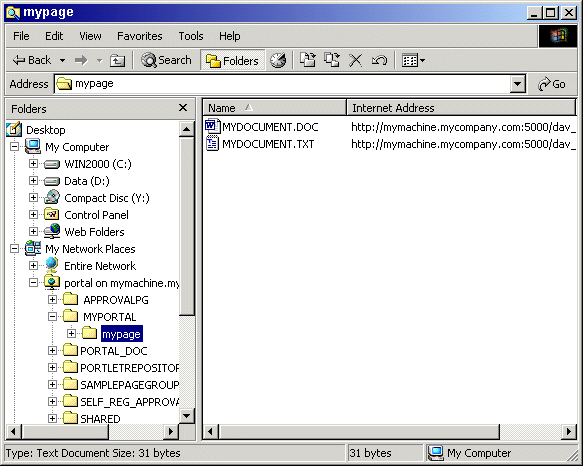18.12 Example: Using Microsoft Office 2000 to Edit Portal Page Content
If you are using Microsoft Office 2000, a WebDAV-enabled desktop application, you can start the application, open a portal file that is exposed in a Web Folder, edit the content, and save it back to the portal. There is no need to download the document from the portal and then upload it again after you have edited it.
Figure 18-6 Microsoft Office 2000 Example

Description of "Figure 18-6 Microsoft Office 2000 Example"
To use Microsoft Office 2000 to edit the content of a page:
-
Set up Web Folders to access the portal through Windows Explorer, and then drill down to the page containing the file item to be edited.
See Section 18.11, "Example: Using Web Folders to Add Content to a Portal Page".
For example, Scott drills down to page
mypagecontaining a Word document (MYDOCUMENT.DOC). See Figure 18-6. -
Double-click the file.
-
If prompted, enter your portal user name and password.
The selected file is opened by the relevant Microsoft Office 2000 application. For example, when Scott double-clicks MYDOCUMENT.DOC, it opens in Microsoft Word.
When opening a file, Microsoft Office 2000 locks the file and the related item is checked out in the portal. If the Office application cannot lock the file (that is, it is locked by another WebDAV client, or the item was checked-out in the portal) then it is opened as read-only. If the Office application locked the document when it was opened, it unlocks it when the document is closed.
-
Edit the document, and choose File then Save.
-
Exit Microsoft Word.
When you next access the file item in the portal, note that it includes the changes you made.
Note:
You can also use Office 2000 to create new items in the portal. Simply create the file and then save it directly to the Web Folder for your portal. The item is created as the default WebDAV item type for regular files, and is added to the default item region. For more information, see Section 18.2.1, "Specifying Default Item Types for Zip and WebDAV Uploads".